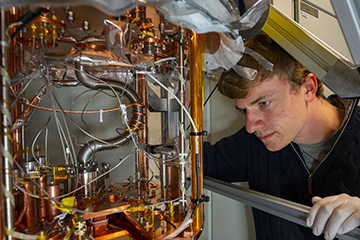
An artist’s impression of erbium atoms (in red and orange) integrated into a silicon waveguide. Researchers in Germany measured the atoms’ optical output, revealing erbium to be a strong candidate for qubits that could link up quantum computers in the future. [Image: C. Hohmann/MCQST; Optica 8, 40 (2021)]
Quantum bits coupled by light could potentially scale up the modest quantum computers of today and link those computers together as part of a globe-spanning quantum internet. But such qubits would have to possess a number of demanding and often conflicting characteristics—being, ideally, durable, efficient, linkable over long distances, and easy to fabricate.
Physicists in Germany reckon they might have found the right candidate in the form of single erbium atoms embedded within silicon crystals. Such qubits, the researchers point out, could operate at standard telecom wavelengths and form devices made using conventional chip-manufacturing techniques. The team has now shown that these atomic dopants can also emit photons over a very narrow range of frequencies and operate coherently at the relatively balmy temperature of 8 K (Phys. Rev. X, doi: 10.1103/PhysRevX.12.041009).
Exploiting silicon
Quantum computers can, in theory, hugely outperform their classical counterparts thanks to qubits’ ability to exist in arbitrary superpositions of 0s and 1s. But to date, scientists have not managed to build computers containing more than a few dozen qubits; such is the difficulty of operating them without destroying their delicate quantum states. Qubits come in various forms—those made from trapped ions and superconducting circuits being among the most popular—but each technology has its pros and cons.
By making qubits from the spins of electrons in atoms or defects, added to crystalline materials, it is possible to take advantage of solid-state technology, particularly that of silicon. Fabricating quantum processors from silicon chips would mean not only being able to exploit existing semiconductor manufacturing infrastructure but also benefiting from silicon’s relatively noise-free environment—its naturally occurring form contains quite small numbers of nuclear spins.
Adding erbium
In the latest work, Andreas Reiserer and colleagues at the Max Planck Institute for Quantum Optics, Germany, study one particular type of silicon dopant: erbium. This is not the only element that scientists have tried out for the job (another is phosphorus), but it has the virtue of emitting coherent radiation within the main optical telecommunication band, making it a natural candidate for quantum network technology. Until now, however, no one had been able to insert erbium atoms reproducibly into a suitable specific point within silicon’s crystalline unit cell.

Andreas Gritsch, the first author of the current work, working on the experimental setup. [Image: Thorsten Naeser, Max Planck Institute for Quantum Optics]
Last year, Reiserer and co-workers carried out resonant spectroscopy on erbium atoms integrated into a 0.4-mm long silicon waveguide (Optica, doi: 10.1364/OPTICA.413330). In contrast with earlier experiments incorporating off-resonant excitation, the researchers observed a limited number of narrow fluorescence peaks—which is desirable if multiple atoms are to be addressed simultaneously in a quantum processor. But the results were still not ideal, since the number and position of those peaks depended on how exactly the erbium was implanted into the silicon.
The researchers reckon this problem was caused by erbium atoms clustering rather than being distributed evenly throughout the silicon lattice. And this, they say, was due to the way the atoms interacted with other impurities present in the silicon. The larger the erbium dose, the greater the concentration of impurities and the higher the annealing temperature, the more clusters form and the more optical lines are generated, the researchers explain. (The annealing is needed to reduce the damage caused by implanting dopants.)
Their response, quite simply, was to use purer silicon and restrict annealing temperatures to no more than 800 K. Doing so, they were able to target certain favorable sites within the silicon and thereby improve the waveguide’s optical output—in particular, narrowing the width of the optical lines quite dramatically from about 100 MHz to around 10 kHz. What’s more, they were able to maintain quantum coherence at temperatures as high as 8 K, which, they point out, can be reached using well-established and relatively cheap liquid-helium refrigeration.
Toward an extended quantum network
Reiserer and colleagues say that such qubits could potentially form the basis of individual quantum computers. But the researchers reckon the qubits would probably be better suited in linking different computers together, either to form one larger, distributed computer or to create an extended quantum network—perhaps even a global quantum internet. Such qubits would be entangled with one another via photons and could also have their states stored over long periods of time by transferring the states to erbium atoms’ nuclei.
Before that can happen, however, the researchers must first show that they can indeed link up separate qubits at some distance from one another. This will involve the emission of photons from two remote dopants and then the detection of those photons after they interfere at a beam splitter. The remaining hurdle, says Reiserer, is making the photon emission fast and efficient enough, which, he adds, can be done by integrating the dopants into an optical resonator. “We have recently demonstrated this using another host crystal,” he says, “so we believe we will demonstrate everything that is required in the coming years.”
